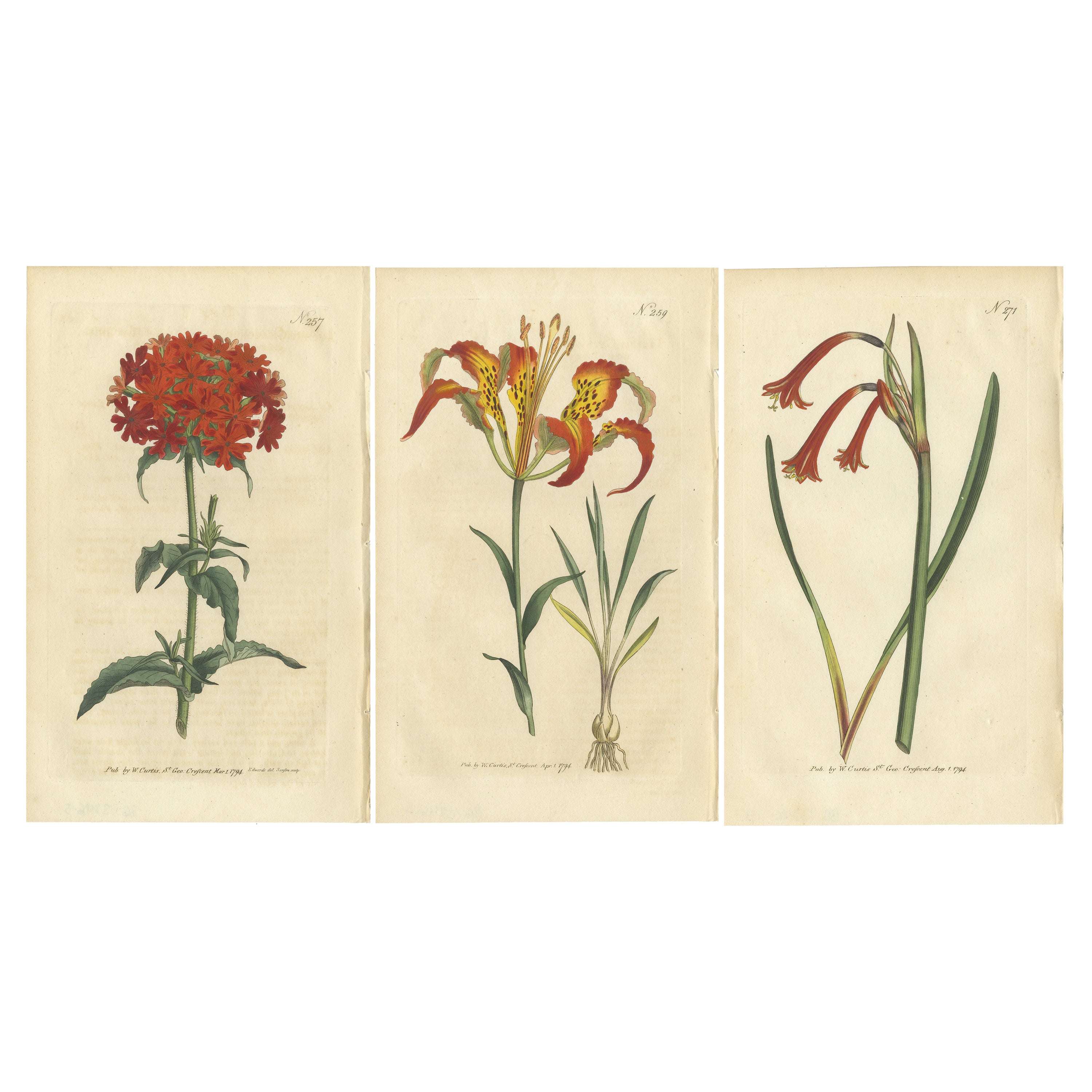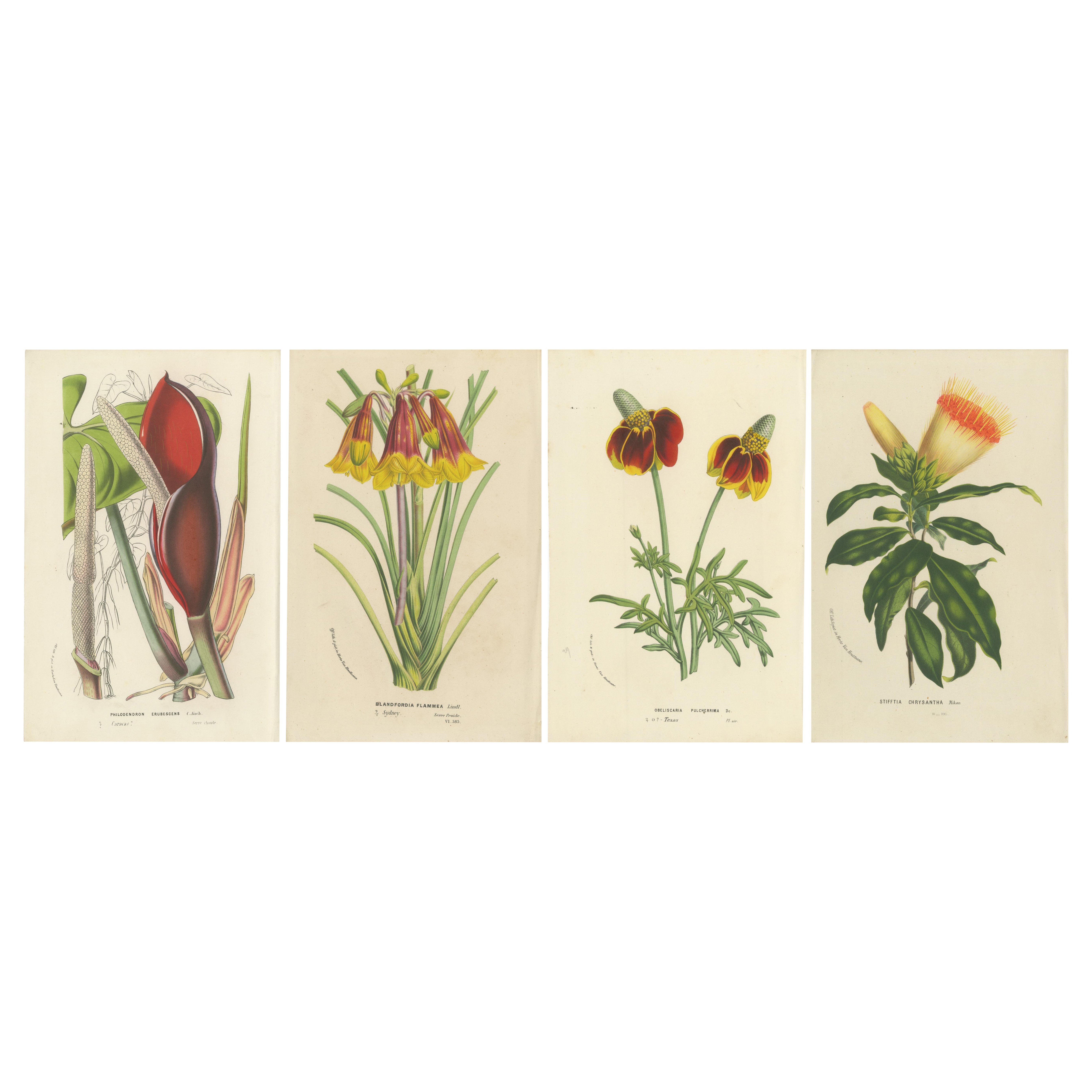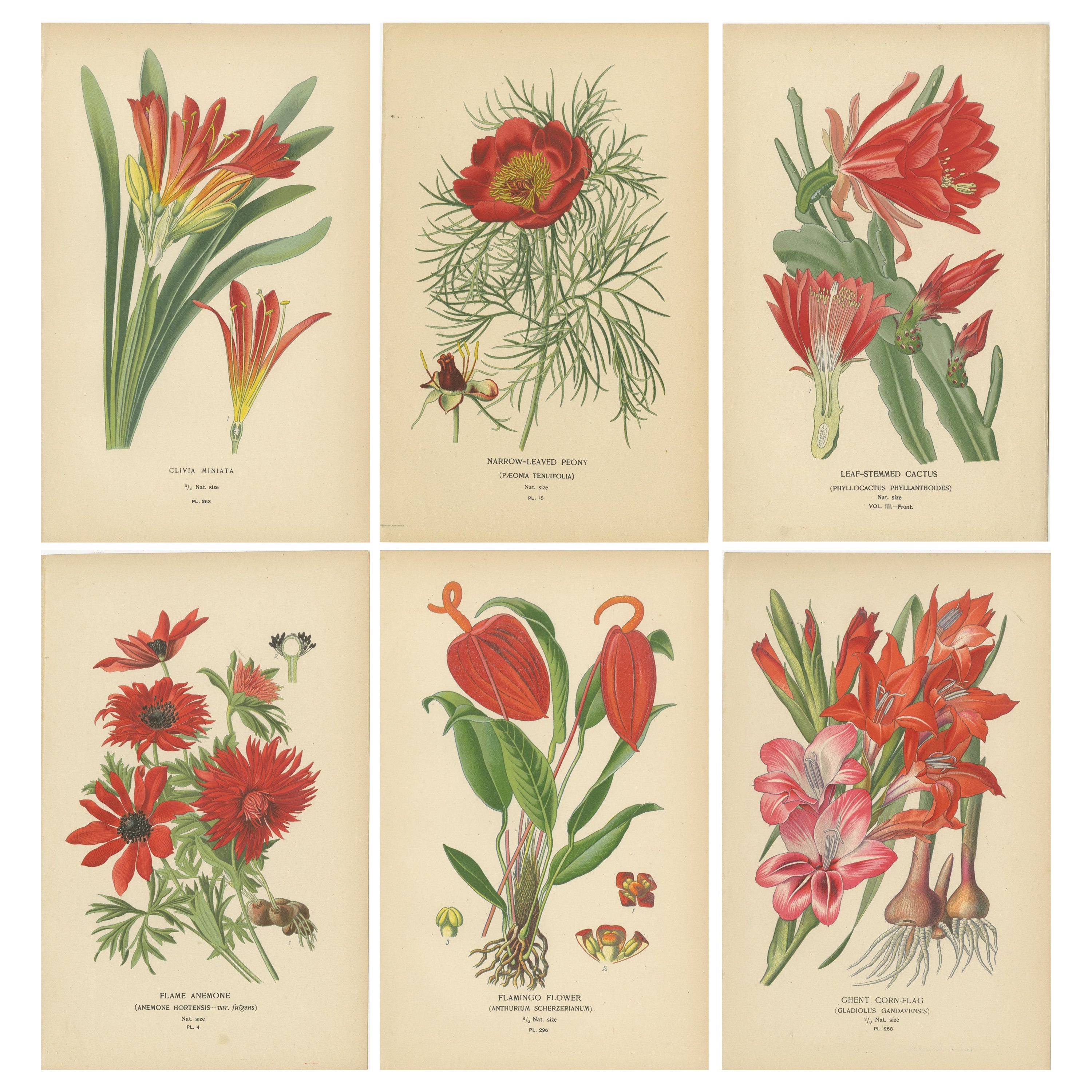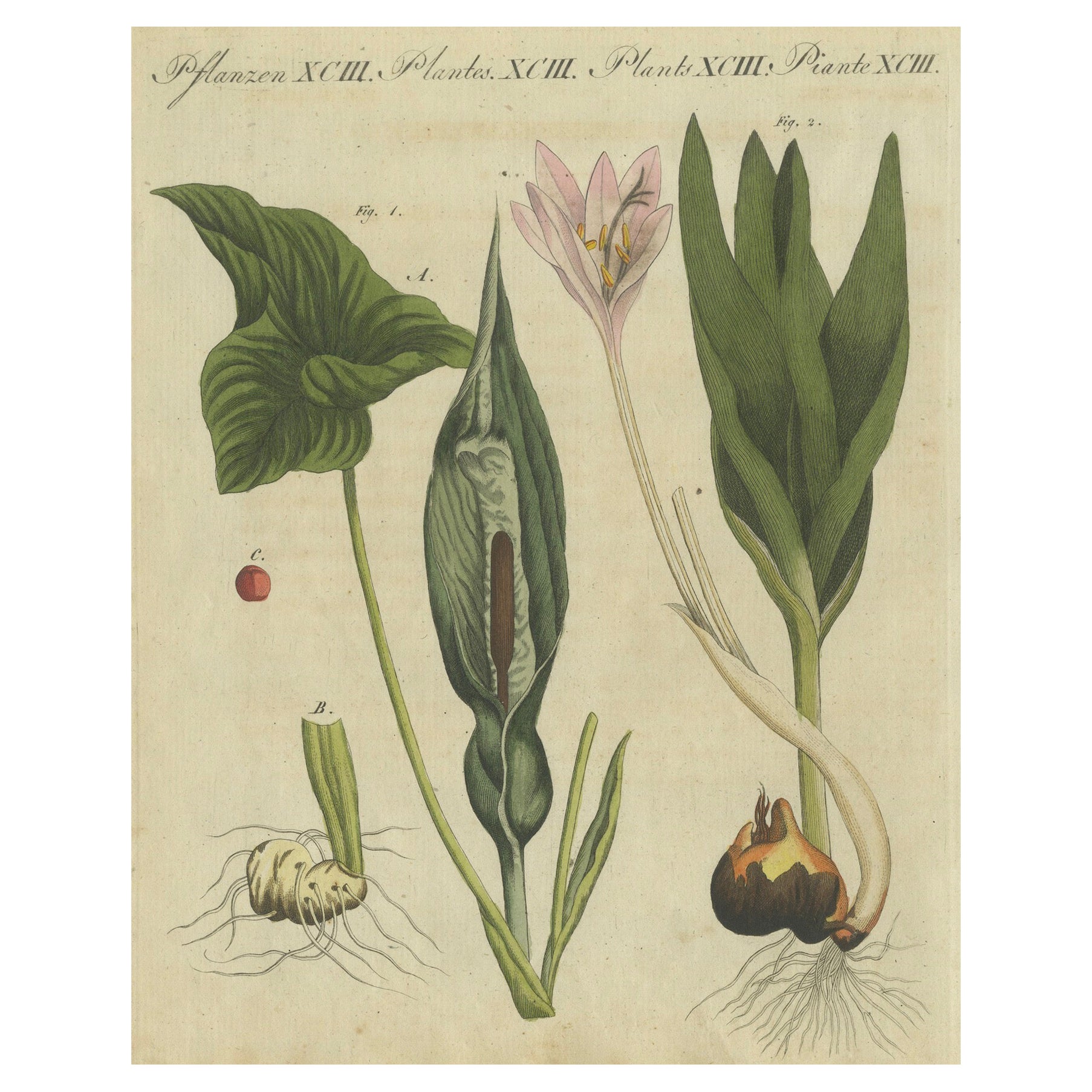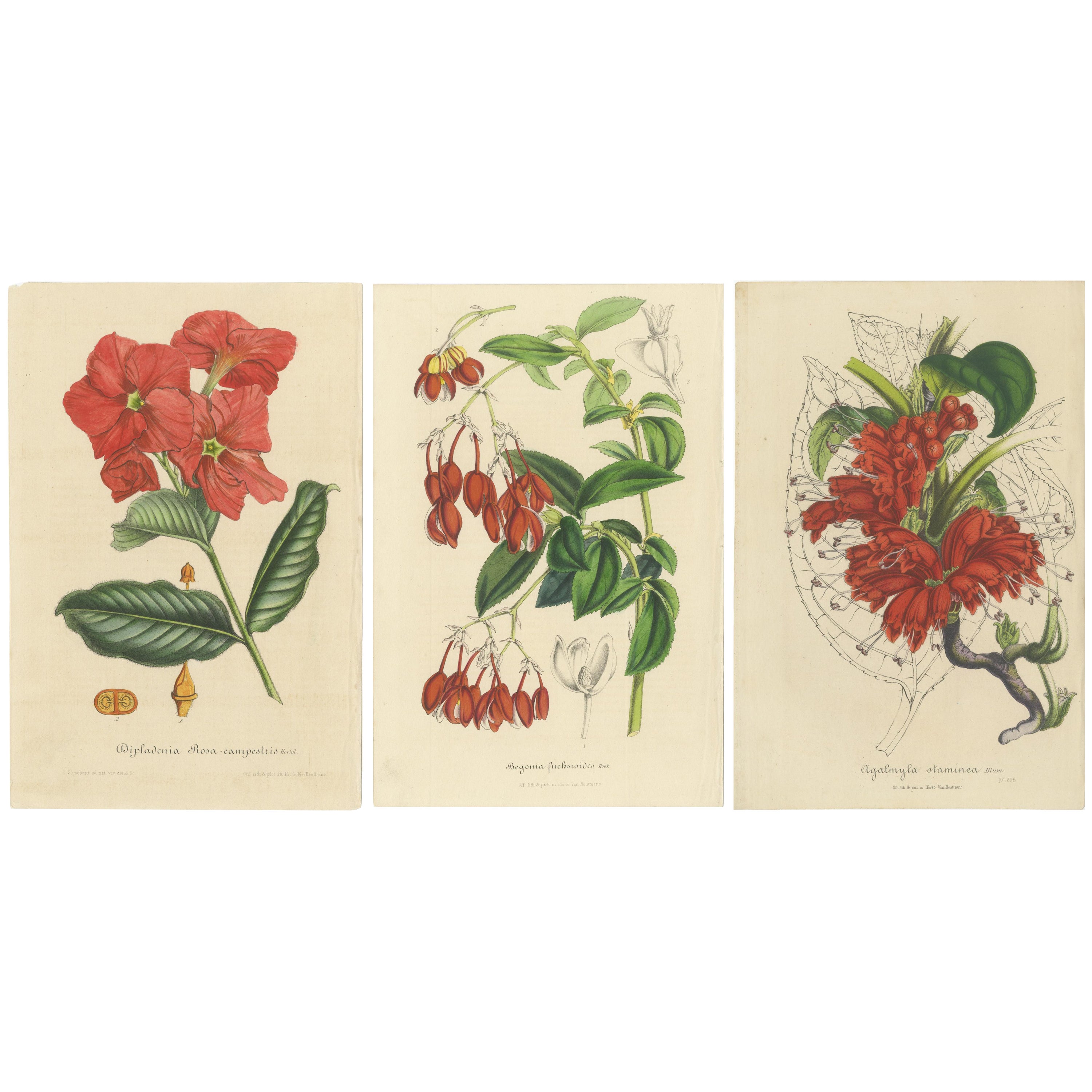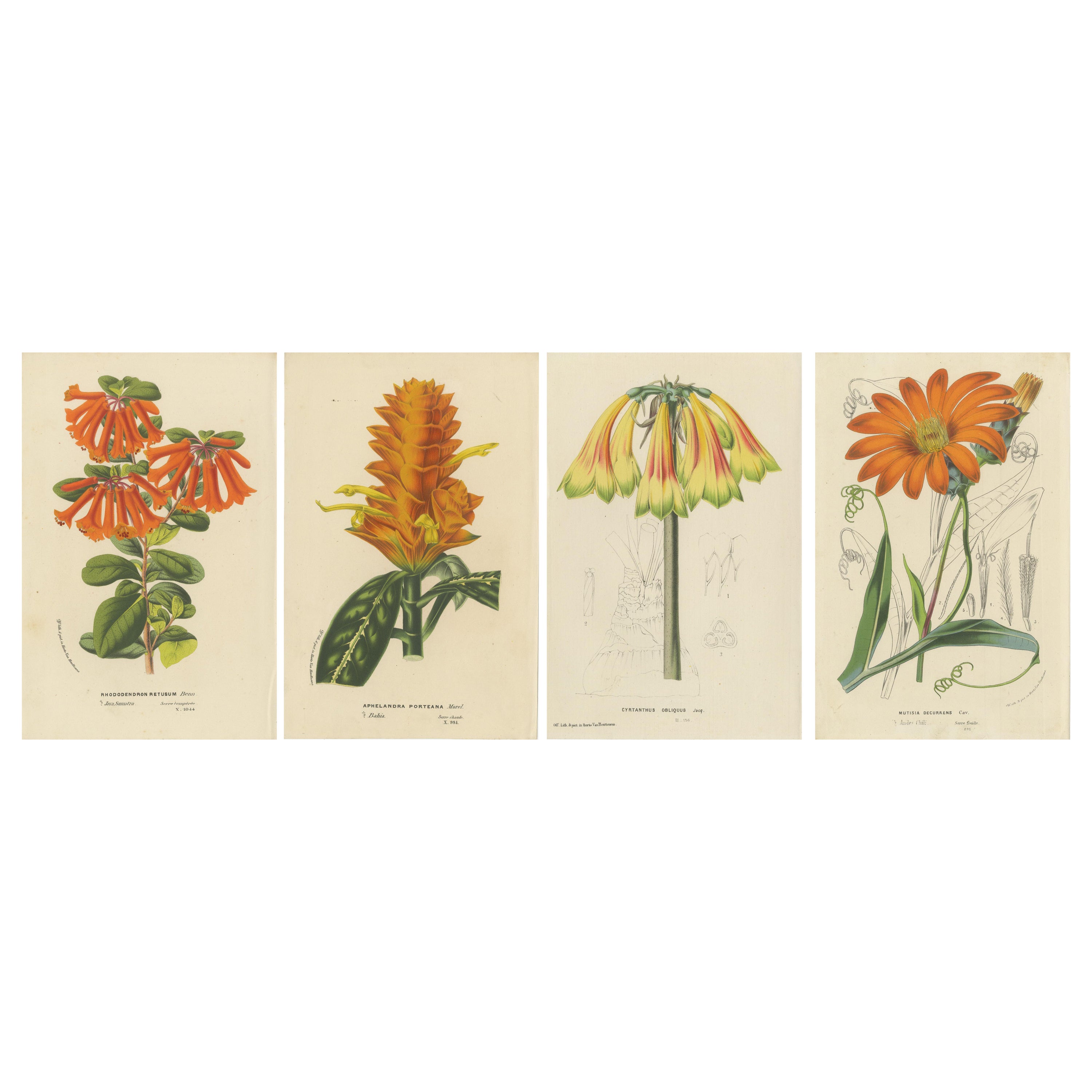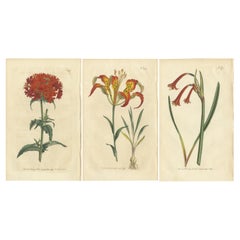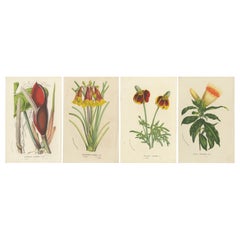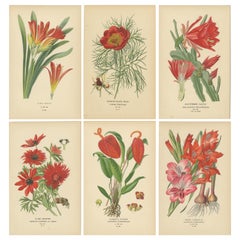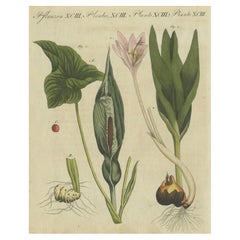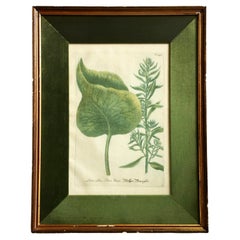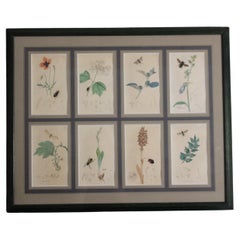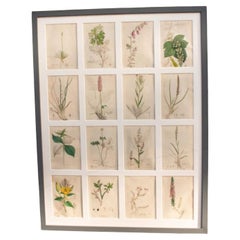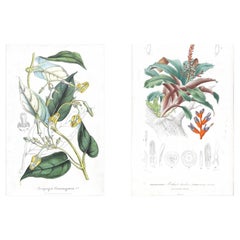Items Similar to Botanical Elegance: Antique Engravings from Johann Weinmann's Masterpiece, 1748
Want more images or videos?
Request additional images or videos from the seller
1 of 6
Botanical Elegance: Antique Engravings from Johann Weinmann's Masterpiece, 1748
$759.02
$948.7820% Off
£559.02
£698.7720% Off
€632
€79020% Off
CA$1,032.59
CA$1,290.7420% Off
A$1,147.44
A$1,434.3020% Off
CHF 601.27
CHF 751.5920% Off
MX$14,071.28
MX$17,589.0920% Off
NOK 7,668.84
NOK 9,586.0520% Off
SEK 7,214.56
SEK 9,018.2120% Off
DKK 4,811.32
DKK 6,014.1520% Off
Shipping
Retrieving quote...The 1stDibs Promise:
Authenticity Guarantee,
Money-Back Guarantee,
24-Hour Cancellation
About the Item
Artist or Maker: Johann Wilhelm Weinmann
Title: "Lilium album peregrinum. Lilium buliferum, Knöpfigte Feuer Lilien. Lilium croceum minus, Feuer Lilien."
Medium: Colored etching
Catalog Number: N.655
Source: "Duidelyke vertoning eeniger duizend in alle vier waerelds deelen wassende bomen, stammen, kruiden" (A Clear Representation of Several Thousand Trees, Shrubs, Herbs, Growing in All Four Parts of the World)
Publication Date: Amsterdam, 1748
Title: "Botanical Elegance: Antique Engravings from Johann Weinmann's Masterpiece"
Description: This exquisite antique engraving, part of Johann Wilhelm Weinmann's renowned work "Duidelyke vertoning eeniger duizend in alle vier waerelds deelen wassende bomen, stammen, kruiden" (A Clear Representation of Several Thousand Trees, Shrubs, Herbs, Growing in All Four Parts of the World), offers a captivating glimpse into the 18th-century botanical world.
The intricately detailed illustration showcases the delicate beauty of various lily species, including "Lilium album peregrinum," "Lilium buliferum" (Knöpfigte Feuer Lilien), and "Lilium croceum minus." Each flower is brought to life through vibrant hand-colored etching, highlighting their unique characteristics and colors.
This engraving is a testament to the meticulous artistry and scientific dedication of the era. The catalog number "N.655" in the top corner adds historical significance to this piece. It is a window into the botanical knowledge of the time, offering both a scientific record and a work of art that continues to inspire admiration for the natural world.
- Dimensions:Height: 16.93 in (43 cm)Width: 9.85 in (25 cm)Depth: 0 in (0.02 mm)
- Materials and Techniques:
- Period:1740-1749
- Date of Manufacture:1748
- Condition:Good. Slightly unevenly trimmed left blank margin (remaining width of blank margin still at least 1 cm.) Study the images carefully.
- Seller Location:Langweer, NL
- Reference Number:Seller: BG-13715-21stDibs: LU3054338129982
About the Seller
5.0
Recognized Seller
These prestigious sellers are industry leaders and represent the highest echelon for item quality and design.
Platinum Seller
Premium sellers with a 4.7+ rating and 24-hour response times
Established in 2009
1stDibs seller since 2017
2,494 sales on 1stDibs
Typical response time: 1 hour
- ShippingRetrieving quote...Shipping from: Langweer, Netherlands
- Return Policy
Authenticity Guarantee
In the unlikely event there’s an issue with an item’s authenticity, contact us within 1 year for a full refund. DetailsMoney-Back Guarantee
If your item is not as described, is damaged in transit, or does not arrive, contact us within 7 days for a full refund. Details24-Hour Cancellation
You have a 24-hour grace period in which to reconsider your purchase, with no questions asked.Vetted Professional Sellers
Our world-class sellers must adhere to strict standards for service and quality, maintaining the integrity of our listings.Price-Match Guarantee
If you find that a seller listed the same item for a lower price elsewhere, we’ll match it.Trusted Global Delivery
Our best-in-class carrier network provides specialized shipping options worldwide, including custom delivery.More From This Seller
View AllThree Botany Prints Full Color Original Engravings, 1794
Located in Langweer, NL
Set of 3 antique botany prints. It shows the Scarlet Lychnis, Catesby's Lily and Narrow-Leaved Cyrtanthus. These prints originate from '...
Category
Antique Late 18th Century Prints
Materials
Paper
Flora Illustrated: A Collection of 19th Century Botanical Art, Published c.1875
Located in Langweer, NL
The prints depict various botanical species, each illustrated with detailed attention to the morphology of the plants, including leaves, flowers, and sometimes fruits or seeds. These...
Category
Antique 1870s Prints
Materials
Paper
$325 Sale Price / set
20% Off
Botanical Illustrations from the Victorian Era: A Visual Celebration of Flora
Located in Langweer, NL
These are vibrant chromolithographs from "Favourite Flowers of Garden and Greenhouse" by Edward Step, illustrated by Désiré Bois and published in 1896 by Frederick Warne & Co., Londo...
Category
Antique 1870s Prints
Materials
Paper
$470 Sale Price / set
20% Off
Elegant 1805 Hand-Colored Botanical Engraving of Bulbous Plants from Bertuch
Located in Langweer, NL
Title: Elegant 1805 Hand-Colored Botanical Engraving of Bulbous Plants from Bertuch
Description:
This detailed hand-colored botanical engraving is taken from Friedrich Justin Be...
Category
Antique Early 1800s Prints
Materials
Paper
Exquisite Botanical Illustrations from Curtis’s Botanical Magazine (1847)
Located in Langweer, NL
These beautiful hand-colored botanical illustrations, drawn and lithographed by the renowned artist Walter Hood Fitch, were featured in Sir William Jackson Hooker's *"Curtis's Botanical Magazine,"* published in London in 1847. Fitch was one of the most prolific and skilled botanical illustrators of the 19th century, known for his ability to capture the intricate details and vibrant hues of the plants he depicted.
Sir William Jackson Hooker, a famous British botanist and the director of the Royal Botanic Gardens, Kew, commissioned these illustrations as part of his work to document newly discovered plants from around the world. The *Curtis’s Botanical Magazine* has been published since 1787 and remains one of the longest-running botanical periodicals.
Detailed Descriptions of Each Plant
#### 1. **Dipladenia Rosa-campestris** (*Hortul. ex Veitch*)
- **English Name**: Rose Dipladenia
- **Description**: This illustration showcases *Dipladenia rosa-campestris*, a striking flowering plant known for its showy pink to deep red trumpet-shaped flowers. Native to tropical regions of South America, particularly Brazil, *Dipladenia* belongs to the family Apocynaceae and is prized in horticulture for its vibrant blooms and ability to climb. Fitch's illustration emphasizes the waxy leaves and the vivid color of the petals, bringing the plant to life on the page.
#### 2. **Begonia fuchsioides** (*Hook.*)
- **English Name**: Fuchsia-flowered Begonia
- **Description**: The *Begonia fuchsioides* is depicted with its characteristic red, pendulous flowers, which closely resemble the blooms of fuchsia plants. This species of Begonia is native to tropical regions and is popular for its delicate, bell-shaped flowers and glossy leaves. Fitch’s attention to the arrangement of the leaves and the contrast between the flowers' vibrant red and the soft green leaves provides a lifelike representation of this exotic plant.
#### 3. **Agalmyla staminea** (*Blume*)
- **English Name**: Staminate Agalmyla
- **Description**: This illustration captures the unique red tubular flowers of *Agalmyla staminea*, a plant native to Southeast Asia. The species is part of the Gesneriaceae family and is known for its bright, showy flowers that grow in dense clusters. Fitch’s careful rendering of the plant’s leaves and the intricate veining, along with the vibrant red flowers, highlights his talent for bringing the botanical subject to life with both scientific accuracy and artistic flair.
### About the Makers
#### **Walter Hood Fitch** (Artist and Lithographer)
Walter Hood Fitch (1817–1892) was one of the most influential botanical artists of the 19th century, working primarily with Sir William Hooker and later his son, Joseph Dalton Hooker, at Kew Gardens. He produced thousands of illustrations for various botanical publications, including *Curtis’s Botanical Magazine*, where he was responsible for the majority of its plates from 1834 to 1877. Fitch’s mastery of lithography allowed him to create richly detailed and accurate depictions of plants, with a particular talent for illustrating both the botanical structure and the vibrant colors of flowers.
#### **Sir William Jackson Hooker** (Director and Editor)
Sir William Jackson Hooker (1785–1865) was a prominent British botanist and the director of the Royal Botanic Gardens, Kew. Under his leadership, Kew Gardens expanded its collection of plants from around the world, and Hooker was instrumental in promoting the scientific study and illustration of these species. As the editor of *Curtis’s Botanical Magazine*, Hooker collaborated with Fitch to document and share the beauty and diversity of plants with the scientific community and the public.
### The Lithographic Technique
Lithography, particularly chromolithography, was a crucial innovation in botanical illustration. Fitch was skilled in the traditional method of lithography, where an image was drawn onto a stone plate with a greasy substance and then inked for printing. Hand-coloring was often applied afterward to bring the prints to life, as seen in these illustrations. This method allowed for highly detailed, accurate representations of plants and their botanical features, making it invaluable for both scientific study and aesthetic appreciation.
### Conclusion
These prints from *Curtis’s Botanical Magazine* reflect the height of botanical art in the mid-19th century. The combination of Walter Fitch...
Category
Antique 1840s Prints
Materials
Paper
$413 Sale Price / set
20% Off
Vibrant Botanical Portraits: Exquisite Plant Illustrations from the 19th Century
Located in Langweer, NL
These illustrations, executed with precision and rich coloration, are fine examples of chromolithography, a technique popular in the 19th century for its ability to produce vivid, mu...
Category
Antique 1870s Prints
Materials
Paper
$364 Sale Price / set
20% Off
You May Also Like
1736-45 Framed Botanical Engraving, Johann Wilhelm Weinmann
By Johann Wilhelm Weinmann
Located in Louisville, KY
Framed Botanical Engraving, Johann Wilhelm Weinmann. Johann Wilhelm Weinmann (German 1683-1741) Published in Amsterdam & Ratisbon, 1736-45....
Category
Antique Mid-18th Century German Other Prints
Materials
Velvet, Giltwood, Paper
Botanical Engravings by John Curtis 19th century
Located in Seaford, GB
19th Century Botanical Engravings: A Timeless Art Form
The Legacy of John Curtis and 19th-Century Botanical Engravings
🖋 Provenance Story – 19th Century Botanical Engravings with ...
Category
Antique 19th Century British Victorian Prints
Materials
Paper
$1,828 Sale Price / set
20% Off
18th century James Sowerby botanical Engravings
By James Sowerby
Located in Seaford, GB
Rare Antique Botanical Prints by James Sowerby (1757–1822): A Timeless Tribute to British Flora
Step into the enchanting world of 18th-century botanical artistry with our exceptiona...
Category
Antique 1790s British Georgian Prints
Materials
Paper
$3,578 / set
Set of Two Rare Botanical Engravings by D’Orbigny — 1849
Located in Fukuoka, JP
Set of Two Rare Botanical Engravings by D’Orbigny — Dictionnaire Universel d’Histoire Naturelle, Paris, 1849
An exquisite pair of original hand-colored botanical engravings from the...
Category
Antique 19th Century French Prints
Materials
Paper
Johann Weinmann: c18th Botanical Engravings in Decalcomania Frames
Located in Richmond, GB
A wonderful selection of hand-coloured mezzotint engravings from: ""Phytanthoza Iconographia"", c1739, presented in hand- made parcel-gilt, ebonised and decalcomania frames.
Joha...
Category
18th Century More Prints
Materials
Watercolor, Mezzotint
Botanical Print, Corona Imperialis Polvanthus, After Basil Besler
By Basilius Besler
Located in Bradenton, FL
The hand-colored botanical print, Corona Imperialis Polyanthos or Crown Imperial Lily, was originally by Basil Besler (1561-1629) a Nuremberg, Germany pharmacist, and published in t...
Category
20th Century German Baroque Prints
Materials
Paper
More Ways To Browse
Chest Of Drawers With Pull Out Desk
Chinese Altar Vase
Chinese Carved Celadon Jade
Chinese Cloisonne Plate
Chinese Dragon Embroidered
Chinese Emperor Empress
Chinese Enamel Teapot
Chinese Frog
Chinese Ink Box
Chinese Table With Mother Of Pearl Inlay
Chinoiserie Fans
Chippendale Locked Cabinet
Clay Water Jug
Coiled Rattan
Column Indonesia
Concrete Garden Animals
Copper Buddha
Danish Teak Secretary Desk
